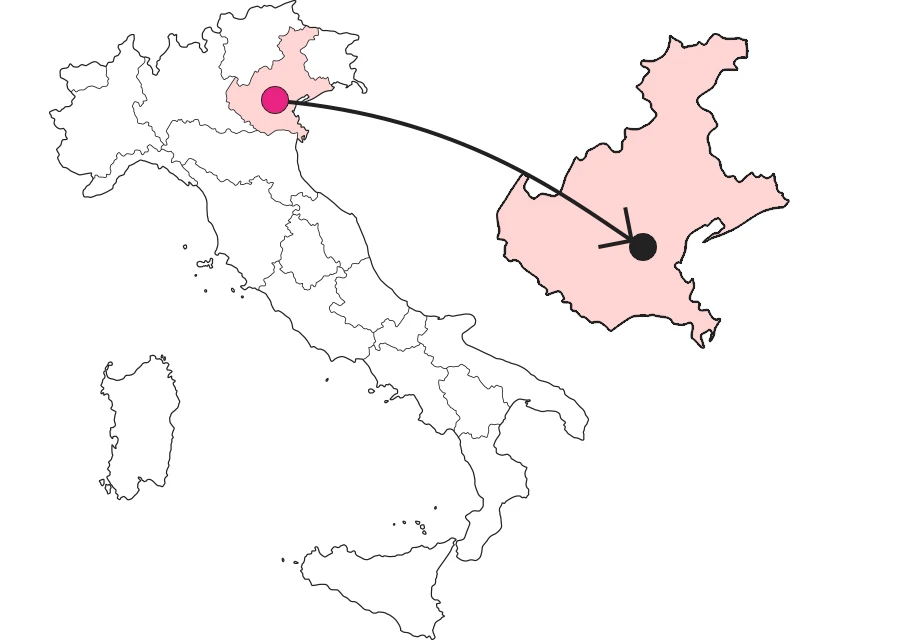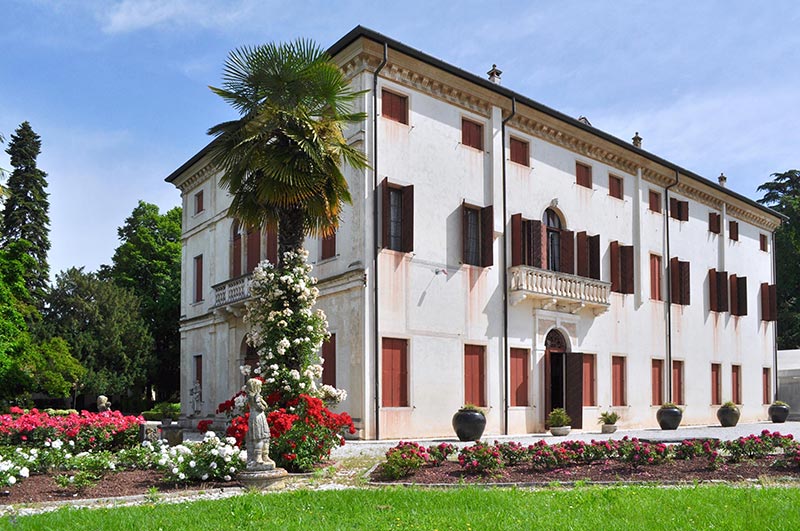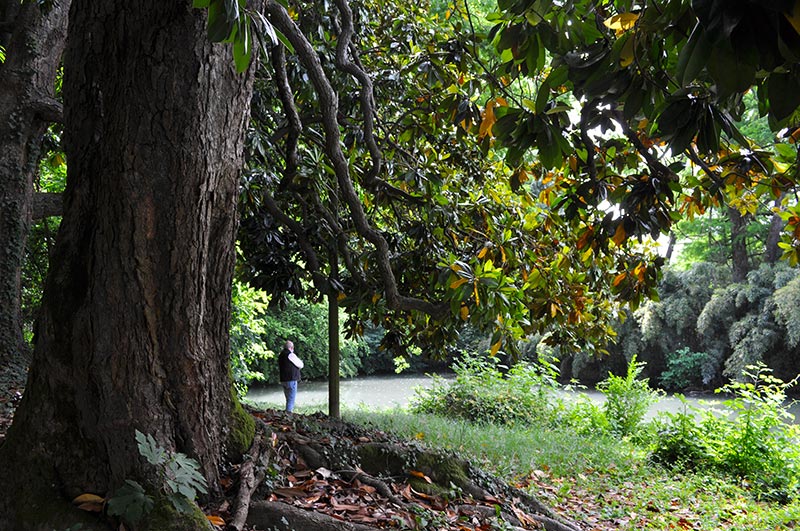SHARRYLAND


Villa Wollemborg, but what a beautiful story!
We stroll through the romantic park while the guide tells about the philanthropic economist who started the first Cassa Rurale in Italy



Where is

Veneto, too, at the time of Cisalpine Gaul, had its own Via Aurelia...laid out by Consul Claudius Aurelius Cotta, it started from Patavium (Padua) and went straight up to Acelum (Asolo). About halfway up it stopped at Laurelia, today's Loreggia, which therefore has significant origins. The consular road is matched today by the Strada del Santo, which from time to time still reserves rural scenery of ancient beauty, the mosaic of cultivated land outlined by streams and rows of cypress trees.
Villa Wollemborg appears beyond the curve of a canal, amid the box hedges and cypress trees of the Italianate garden; as a backdrop, the romantic park, beyond which a large agricultural estate once stretched. An important building, in which one can recognize signs of the first fifteenth-century construction phase, when it was flanked by a dovecote tower. This was the time when the Venetian Republic was beginning to look to the mainland as the setting for the economic and architectural flowering that would take on the contours of a true villa civilization.
The Loreggia estate ties its history first to the Polcastro family, which was succeeded by the Querini Stampalia, another name of the highest class in the Serenissima, who finally gave way to the Jewish Wollemborg family, German by origin and Paduan by adoption. Those who love fictional events will find bread for their teeth, especially since Professor Marconato, a historian of the Alta Padovana and former mayor of Loreggia, more than a guide is a sort of tutelary deity of the place.
 The fifteenth-century villa owes its current appearance to works in the early nineteenth century
The fifteenth-century villa owes its current appearance to works in the early nineteenth centuryFamily entanglements aside, the villa is inextricably linked to the figure of Leone Wollemberg (1859-1932), one of the most prominent figures in Italy between the nineteenth and twentieth centuries: brilliant studies in law at Padua, but above all an early vocation for philanthropic activities that earned him in 1889 the gold medal of the Universal Exhibition in Paris and in 1901 the appointment as commendatore of the Order of Saints Maurice and Lazarus. His name is remembered above all for the founding in 1883 of the first Cassa Rurale in Italy, precisely in Loreggia, following the example of which these meritorious cooperative credit institutions, for the first time close to the needs of the rural world, later spread throughout the nation.
Indeed, in economics we speak of a 'social elevator' to denote the process of enabling individuals to improve their class status, and of "access to credit" as one of the determining factors in triggering this desirable progress. For centuries, however, borrowing meant exposing oneself to the risk of entering the deleterious spiral of usury. In the cities of the Middle Ages it was the so-called 'pawnshops' that curbed the scourge of credit on unfair terms. Towards the end of the nineteenth century, on the other hand, as far as the specifics of the rural world were concerned, it was the rural banks that offered long-term, low-interest financing to peasants, when it was a matter, for example, of redeeming a farm, moving from the condition of sharecropper to that of owner of one's own farm.
 Beyond this large magnolia, a glimpse of the romantic park
Beyond this large magnolia, a glimpse of the romantic parkThe founding of the Cassa Rurale of Loreggia was for Leone Wollemborg the first step in a brilliant political career: in fact, in 1892 he was elected to the Chamber of Deputies representing the Cittadella constituency, and in 1901 he even served as Minister of Finance of the Kingdom of Italy in the Zanardelli government. "Politics must not be for anyone a way to make a career," - these, his words at a rally - "but a hard militia, in which one must bring much fire of love and much study of thought."
Always close to the rural world, Wollemborg is best remembered for the law on "state quinine," the substance that, distributed in salt and tobacco outlets, proved crucial in the fight against malaria, which was claiming thousands of victims in Veneto at the time as well. Frustrated instead in the implementation of important economic reforms, Wollemborg preferred to retire from the political arena. Rather, his name remains linked to the world of cooperative credit so much so that the culmination of his career as a philanthropic economist is considered to be the establishment in 1909 of the Italian Federation of Rural Banks, still operating today although under a different name.
 A bloom of water irises along the canal that frames the estate
A bloom of water irises along the canal that frames the estateThe villa retains a charming 19th-century atmosphere, but the most pleasant part of the visit is the walk through the park that forms its backdrop. It was laid out by Giuseppe Jappelli (1783-1852), whom aficionados know as one of the great names of the Romantic garden, but also remembered for that bizarre architectural marvel of Caffè Pedrocchi, in Padua.
The architect's hand is first of all grasped in the masterful regulation of the Rustega waters that frame the park, offering among other things the thrill of a picturesque walk through a bamboo grove. And it is a moment to catch a glimpse of a kingfisher darting along the water's edge like iridescent lightning.
Botanical enthusiasts will linger in front of certain monumental trees, such as a centuries-old Sophora japonica, whose pendulous branches form a kind of vegetal dome. The path enters the woods and reaches a neoclassical temple, a must-see accessory of English gardens, which in this case houses the mortal remains of Leo Wollemborg.
Then from the shadows of remembrance it is a moment to move to the full sun of thegrassy oval that opens up in the center of the park: a gallop, or horse-riding arena, its probable function, but also an element indicative of the Masonic-inspired chiaroscuro typical of Jappelli's gardens. Intriguing talk, which Professor Marconato will be happy to develop....
 In the heart of the woods, the small temple that houses the mortal remains of Leo Wollemborg
In the heart of the woods, the small temple that houses the mortal remains of Leo WollemborgWith the visit concluded, only one last thing remains to be said. Among Leone Wollemborg's merits is in fact counted the promotion of the Ostiglia-Treviso railway line, a public work that with a long diagonal would have connected the Lombard town on the Po to the city in Veneto by networking with the main cities of the Northeast. The new railroad had reason to be in the strategic framework of the Northeast in the event of war with Austria, but Wollemborg also advocated it because it would serve the territory of Alta Padovana, which he represented in Parliament with a station in his own Loreggia.
In terms of current events, it is interesting to note how the railroad track, decommissioned in the last postwar period, has found a new future as a bicycle and pedestrian path. Among the destinations for an easy ride from Loreggia: the Rotonda di Badoere, especially on the Sundays of the craft market, or the naturalistic area of the Sile springs, starting from the picturesque Cervara mill. One of the most beautiful passages, the footbridge over the Brenta, stretching your gaze toward the tempting little beaches drawn among the willows.
Enter the Map of Italy's Undiscovered Wonders and find treasures where you least expect it... Inspire, Recommend, Share...
Collections
The Map thanks:
Enter the Map of Italy's Undiscovered Wonders and find treasures where you least expect it... Inspire, Recommend, Share...
Where is

Collections

